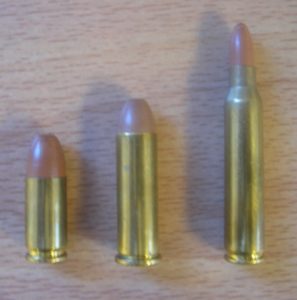Dr Andrew provides an evaluation of firearm Injuries, and the tissue damage associated with them.
The damage caused by projectiles is a function of their kinetic energy, which is transferred to the victim on impact. The amount of energy that the projectile possesses is found in the following formula.
K.E. = W*V2/2g, where
W = weight of the projectile V = velocity of the projectile g = gravitational acceleration
What happens when a projectile impacts a human body?
As the bullet enters the body it crushes and shreds tissue in its path – this creates a permanent cavity – the “bullet hole”. In addition, the energy of the impact is dissipated in a shock wave that radially flings surrounding tissue away from the path of the projectile, creating a cavity larger than the diameter of the bullet, this is the temporary stress cavity. The temporary stress cavity exists for around 5 to 10 milliseconds with a series of gradually smaller pulsations & contractions before the formation of a permanent wound track.
The ultimate extent of the wound is determined by the kinetic energy on impact, extent of the temporary cavity and the amount of bullet fragmentation.
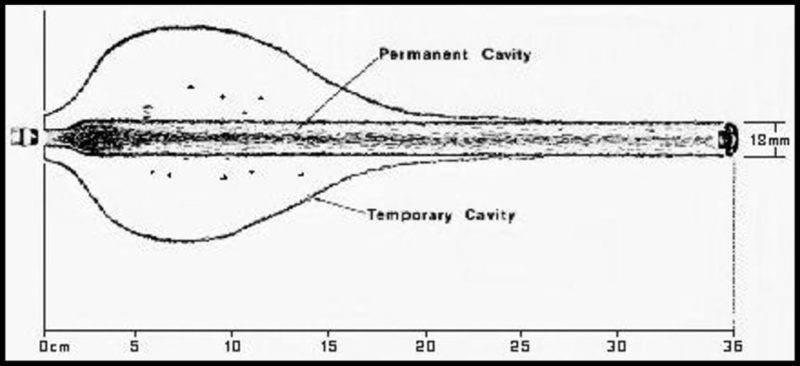
Firearms are divided into the following
- Handguns – including single-shot pistols, Derringers, revolvers, auto-loading pistols
- Rifles – including single-shot, lever-action, bolt-action, pump-action, auto-loading
- Shotguns – including single-shot, double-barrel, bolt-action, lever-action, pump-action, auto-loading
- Sub-machine guns
- Machine guns – including belt-fed and magazine-fed
Ammunition for these small arms include the following
- Cartridge case – including brass, steel or aluminum, straight, bottleneck, tapered (obsolete), rimmed, semi-rimmed, rimless, rebated, belted
- Primer – including centerfire, rimfire
- Propellant (gunpowder) – including ball, flattened ball, flake
- Bullet – including lead (+/- gilding), metal-jacketed (lead or steel core covered by copper/zinc, steel, copper/nickel or aluminum)
- Full (ball, armor piercing, tracer dim, tracer bright, incendiary, armor-piercing incendiary)
- Partial (soft-point, hollow-point)
The extent of the penetration and temporary cavity and the resulting injury is different depending on the type of firearm and ammunition used.
Wounds caused by Hand Guns
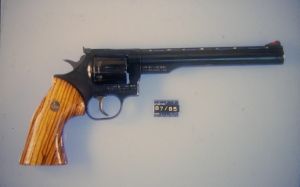
Fackler-derived wound profiles*:
- .45 Caliber 185 grains Silvertip Winchester, velocity 940 ft/sec, 9.8 inch penetration .85 inch expansion
- .357 Magnum 125 grains JSP Remington, velocity 1390 ft/sec, 14.1 inch penetration .66 inch expansion
Features of Entrance Wounds:
- A round to oval defect in which the edges cannot be re-approximated (tissue is destroyed)
- The presence of marginal abrasion distinguishes entrance wound from exit wound
- Range of fire may be determined by the extent of the following on the body or clothing: muzzle imprint, fouling/smudging and stippling/tattooing,
- Direction of fire may be inferred by the distribution of the above features
- Atypical entrance wounds include re-entry wounds, wounds from shrapnel of secondary targets, graze/gutter wounds, ricochet and keyhole wounds.
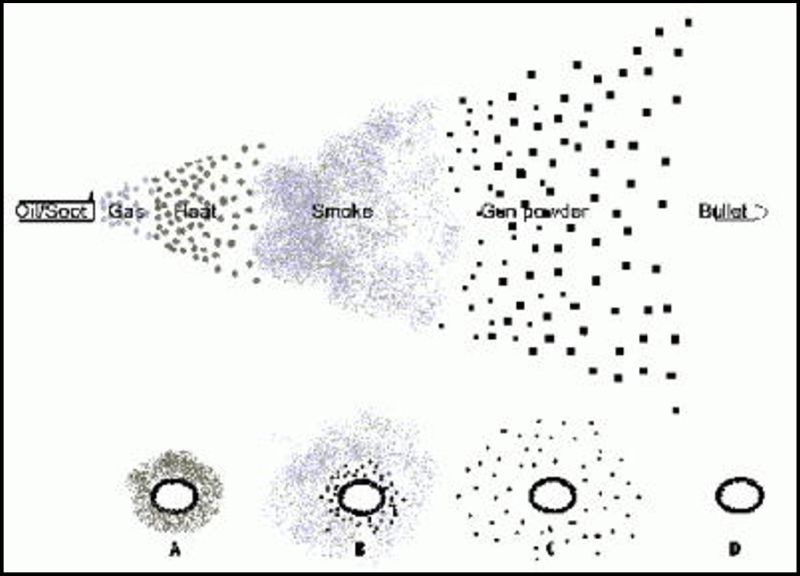
Features of exit wounds
- Marked variability in size and shape
- Edges can be reapproximated (tissue is torn or lacerated)
- Not always larger than entrance
- Shored exit wounds may mimic the marginal abrasion of entrance wounds
Wounds Caused by High-Velocity Rifle Bullets
High velocity rifle bullets produce “tail splash” which is the rearward propulsion of injured tissue and a large temporary cavity 11 to 12.5 times the diameter of the projectile. The maximum cavity diameter occurs at point of maximum loss of kinetic energy (maximum yaw or fragmentation).
The temporary cavity undulates 5 – 10 milliseconds then comes to rest as a permanent track. Alternating positive and negative pressure in wound track pulls foreign material and bacteria into wound track. Finally, rapid expansion of cavity can do severe damage at significant distance from wound path depending on tissue struck.
The striking velocity and bullet mass establish a bullet’s potential for damage, and set the limit on the tissue disruption produced.
Fackler derived wound profiles of bullets of varying mass and velocities*:
- Winchester .30-30, 170-grains Silvertip, velocity 2020 ft/sec, medium velocity, expanding rifle bullet
- Winchester .30-06 (7.62 x 63) 150-grains Softpoint 2923 ft/sec
- 12 gauge 437 grains (1 oz) Foster type rifled slug, 1513 ft/sec, 1 inch wound channel 14 inch penetration
- .223 (5.56 x 45 mm) cartridge fired in the M-16 series, 55 grains bullet at 3250 ft/sec, Muzzle K.E. = 1320 ft-lbs
- .45-70 U.S. Army black powder cartridge circa 1873, 405 grains all lead bullet at 1285 ft/sec, Muzzle K.E. = 1490 ft-lbs
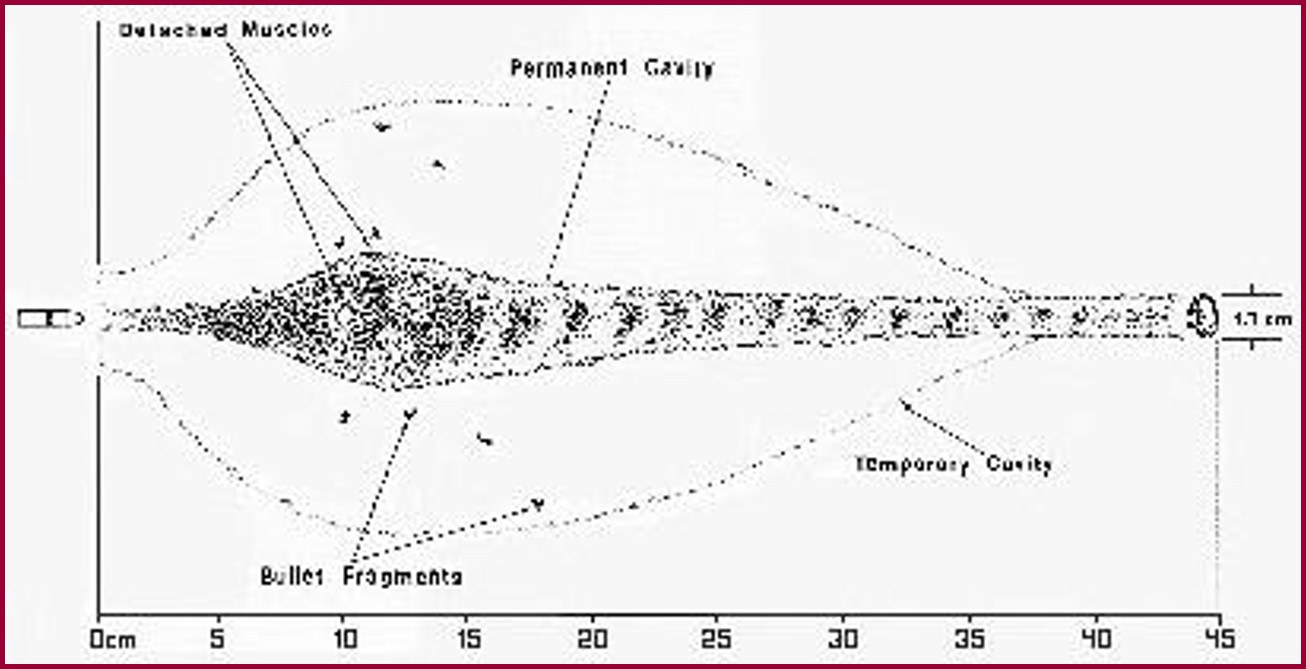
The Impact of Tissue Type
The type of tissue that the bullet strikes determines the effect for example:
- Muscle – high density, elastic, cohesive
- Liver – high density, inelastic, non-cohesive
- Lung – low density, highly elastic
The limits of elasticity are reached at muzzle velocities in excess of 2700 ft/sec
Centerfire Rifle Head Wounds
- Temporary cavity within a rigid structure
- Pressure relieved only by bursting
Wounds caused by Shotguns – Smooth Bore.
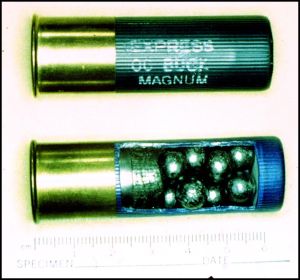
Gauge refers to the number of solid spheres the same diameter as the inside of the barrel that can be made from one pound of lead. In a 12-gauge, 12 lead balls can be made from one pound of lead. In a 20-gauge, 20 lead balls can be made from one pound of lead
Shotgun ammunition typically consists of shells containing small steel or lead spheres that scatter outward once it is fired from the shotgun. Smaller sized spheres are referred to as “bird shot” and larger ones as “buck-shot”. In addition, there are shotgun slugs which are effectively shotgun bullets.
The Choke is the % of shot w/in a specified target at 40 yards:
- Cylinder bore (35-45%)
- Improved cylinder (45-55%)
- Modified (55-65%)
- Full choke (65-75%)
Fackler-derived wound profiles of two types of shotgun ammunition*:
- 12-gauge 27 pellet #4 buckshot, with a velocity of 1350 ft./sec, has a penetration range of 6-10 inches, Compare this to 13” penetration for #1, 14” for 00 and 15” for 000 buckshot
- 12-gauge #4 shot, with a velocity of 1200 ft./sec has a maximum penetration 11 inches, and an average penetration of 5.5 to 7.5 inches
Shotgun Wound presentation
At close range (< 5 feet), wound edge scalloping is observed. Also, soot and powder may be seen out to 5 ft. For distant shots, the effects depend on the weapon and ammunition used, however wadding contusions/abrasions may be seen out to 50 feet
Exit wounds for shotgun victims are rare, even at close range. The most likely scenario being
- Head shot
- Very thin person
- Tangential shot
- 00 buck or rifled slug
Wounds Caused by Bullet Fragmentation
Bullet fragmentation can cause significant additional damage, including a much larger permanent and temporary cavity, torn muscles and holes in internal organs can be as large as 7 cm in diameter.
Conclusion
This article is extracted from a presentation by Dr Andrew. The presentation contains many disturbing images, that are not appropriate for public viewing. If your organization are interested in having Dr Andrew speak on this subject, please contact him by clicking this link.
* The wound profiles are from an article by Martin Fackler: http://www.rkba.org/research/fackler/wrong.html

